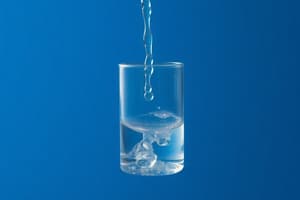Podcast
Questions and Answers
What are the primary components of the cell?
What are the primary components of the cell?
- Cell Wall, Ribosomes, Golgi Apparatus
- Nucleus, Cytoplasm, Mitochondria
- Cell Membrane, Cytoplasm, Organelles (correct)
- Plasma Membrane, Lysosomes, Endoplasmic Reticulum
Which mechanism does NOT allow substances to cross the plasma membrane?
Which mechanism does NOT allow substances to cross the plasma membrane?
- Passive Transport
- Active Transport
- Infiltration (correct)
- Vesicular Transport
What is the primary role of cilia, flagella, and microvilli?
What is the primary role of cilia, flagella, and microvilli?
- Facilitating cell division
- Locomotion and absorption (correct)
- Energy production within the cell
- Protein synthesis
Which transport mechanism involves the consumption of energy?
Which transport mechanism involves the consumption of energy?
What is NOT considered an intracellular component?
What is NOT considered an intracellular component?
What process allows bulk transport of substances into cells?
What process allows bulk transport of substances into cells?
Which fluid compartment contains substances found inside the cell?
Which fluid compartment contains substances found inside the cell?
If the concentration of solutes is higher inside the cell, which process will primarily allow water to move into the cells?
If the concentration of solutes is higher inside the cell, which process will primarily allow water to move into the cells?
What is the primary mechanism by which potassium ions enter cells against their concentration gradient?
What is the primary mechanism by which potassium ions enter cells against their concentration gradient?
What type of fluid comprises components contributing to body mass found outside the cells?
What type of fluid comprises components contributing to body mass found outside the cells?
What transport process is utilized to move packages of substances from inside the cell to the outside?
What transport process is utilized to move packages of substances from inside the cell to the outside?
During Patient X's treatment for dehydration, which type of solution might be administered to balance electrolyte levels?
During Patient X's treatment for dehydration, which type of solution might be administered to balance electrolyte levels?
When a cell needs to intake large molecules, which of the following processes will it likely employ?
When a cell needs to intake large molecules, which of the following processes will it likely employ?
What is the main function of mitochondria in a cell?
What is the main function of mitochondria in a cell?
Which organelle is responsible for synthesizing lipids?
Which organelle is responsible for synthesizing lipids?
Where are ribosomes located within the cell?
Where are ribosomes located within the cell?
What is the primary role of the Golgi apparatus in a cell?
What is the primary role of the Golgi apparatus in a cell?
What does the cytosol primarily consist of?
What does the cytosol primarily consist of?
What defines the rough endoplasmic reticulum (RER)?
What defines the rough endoplasmic reticulum (RER)?
Which cellular structure is not classified as an organelle?
Which cellular structure is not classified as an organelle?
Which component of the cell is referred to as the 'brain'?
Which component of the cell is referred to as the 'brain'?
What defines the primary function of the plasma membrane?
What defines the primary function of the plasma membrane?
Which type of transport does NOT require energy?
Which type of transport does NOT require energy?
How does facilitated diffusion through carrier-mediated transport differ from simple diffusion?
How does facilitated diffusion through carrier-mediated transport differ from simple diffusion?
What is an example of primary active transport?
What is an example of primary active transport?
What does secondary active transport rely on?
What does secondary active transport rely on?
What is the primary function of lysosomes in the cell?
What is the primary function of lysosomes in the cell?
Which statement about peroxisomes is true?
Which statement about peroxisomes is true?
Which component of the cytoskeleton is the strongest among microfilaments, intermediate filaments, and microtubules?
Which component of the cytoskeleton is the strongest among microfilaments, intermediate filaments, and microtubules?
What is the role of the centrosome in the cell?
What is the role of the centrosome in the cell?
What distinguishes an anucleate cell from a multi-nucleate cell?
What distinguishes an anucleate cell from a multi-nucleate cell?
What happens to chromatin during cell division?
What happens to chromatin during cell division?
Which structure is primarily responsible for movement along the cell surface?
Which structure is primarily responsible for movement along the cell surface?
How do microvilli enhance the functionality of cells?
How do microvilli enhance the functionality of cells?
Flashcards are hidden until you start studying
Study Notes
Bulk Transfer of Substances for Cells
- Endocytosis is a process used to bring molecules like polar substances and large molecules into the cell.
- Exocytosis is a process used to move packages of substances from inside the cell to the outside.
Body Fluid Compartments
- The body has two main fluid compartments: intracellular and extracellular.
- Intracellular fluid is the fluid found inside the cell.
- Extracellular fluid is the fluid found outside the cell.
- Extracellular fluid includes interstitial fluid, which surrounds cells, and plasma, the fluid component of blood.
Clinical Application (Vomiting and Diarrhea)
- When a patient experiences vomiting and diarrhea, fluid loss can lead to dehydration.
- Dehydration can cause an electrolyte imbalance, leading to low sodium (hyponatremia) and low potassium (hypokalemia).
- The nursing staff must administer intravenous fluids to restore the body's normal balance.
Question 1: Dehydration and Water Transport
- Osmosis is the process that allows water to move into cells if the concentration of solutes inside the cells is higher than the concentration outside.
Question 2: Potassium Transport
- Active transport is the mechanism that allows potassium ions to move against their concentration gradient.
The Cell: The Basic Unit of Life
- The cell is the smallest living unit.
- Cells contain their own complete set of instructions (genetic material - DNA) for carrying out their individual activities.
Inside the Cell: The Cytoplasm
- Cytoplasm consists of the cytosol and the organelles.
- Cytosol is a jelly-like fluid that suspends the organelles within the cell.
- Organelles are structures within the cell that perform specific functions.
Organelles of the Cytoplasm
- Mitochondria are responsible for providing energy for the cell.
- Ribosomes are the site of protein synthesis.
- The Rough Endoplasmic Reticulum (RER) processes proteins produced by ribosomes and sends them to the Golgi apparatus.
- The Smooth Endoplasmic Reticulum (SER) synthesizes lipids, mobilizes glucose from glycogen, and stores calcium in muscle cells.
- The Golgi apparatus receives proteins from the RER and prepares them for distribution.
- Lysosomes are membranous sacs containing digestive enzymes that break down toxic substances and waste products.
- Peroxisomes are membranous sacs containing oxidase enzymes that detoxify harmful substances.
- Microfilaments, intermediate filaments, and microtubules provide structural support and facilitate movement within the cell.
- Centrosomes are composed of two centrioles and microtubules, generating microtubules and mitotic spindles.
The Nucleus
- The nucleus is considered the brain of the cell.
- The nuclear envelope contains the genetic material, DNA.
- The nucleolus is responsible for forming ribosome components.
- Chromatin consists of DNA and histone proteins that organize the DNA.
Cellular Extensions
- Cilia are short, hair-like projections that move substances along the cell surface.
- Flagella are longer projections that propel the cell itself.
- Microvilli are small, finger-like projections that increase the surface area of the cell, facilitating absorption.
The Plasma Membrane
- The plasma membrane is a lipid bilayer that surrounds the cell, separating the extracellular and intracellular environments.
- The plasma membrane is selectively permeable, regulating the passage of substances across it.
Transportation Across the Plasma Membrane
- Passive transport does not require energy and moves substances down their gradients.
- Simple diffusion allows fat-soluble molecules to move directly through the phospholipid bilayer.
- Facilitated carrier-mediated diffusion uses protein carriers specific for a particular chemical to move substances.
- Facilitated channel-mediated diffusion uses protein channels that are selective based on size and charge to move substances.
- Osmosis refers to the diffusion of water through a specific channel protein (aquaporin) or the lipid bilayer.
- Active transport requires energy and moves substances against their gradients.
- Primary active transport requires ATP to move solutes.
- Secondary active transport harnesses the energy released from one particle going down its electrochemical gradient to drive another particle up its gradient.
Studying That Suits You
Use AI to generate personalized quizzes and flashcards to suit your learning preferences.




